The CB1 cannabinoid receptor is the major cannabinoid receptor at excitatory presynaptic sites in the hippocampus and cerebellum
- PMID: 16540577
- PMCID: PMC6673964
- DOI: 10.1523/JNEUROSCI.4872-05.2006
The CB1 cannabinoid receptor is the major cannabinoid receptor at excitatory presynaptic sites in the hippocampus and cerebellum
Abstract
Endocannabinoids work as retrograde messengers and contribute to short-term and long-term modulation of synaptic transmission via presynaptic cannabinoid receptors. It is generally accepted that the CB1 cannabinoid receptor (CB1) mediates the effects of endocannabinoid in inhibitory synapses. For excitatory synapses, however, contributions of CB1, "CB3," and some other unidentified receptors have been suggested. In the present study we used electrophysiological and immunohistochemical techniques and examined the type(s) of cannabinoid receptor functioning at hippocampal and cerebellar excitatory synapses. Our electrophysiological data clearly demonstrate the predominant contribution of CB1. At hippocampal excitatory synapses on pyramidal neurons the cannabinoid-induced synaptic suppression was reversed by a CB1-specific antagonist, N-(piperidin-1-yl)-5-(4-iodophenyl)-1-(2,4-dichlorophenyl)-4-methyl-1H-pyrazole-3-carboxamide (AM251), and was absent in CB1 knock-out mice. At climbing fiber (CF) and parallel fiber (PF) synapses on cerebellar Purkinje cells the cannabinoid-dependent suppression was absent in CB1 knock-out mice. The presence of CB1 at presynaptic terminals was confirmed by immunohistochemical experiments with specific antibodies against CB1. In immunoelectron microscopy the densities of CB1-positive signals in hippocampal excitatory terminals and cerebellar PF terminals were much lower than in inhibitory terminals but were clearly higher than the background. Along the long axis of PFs, the CB1 was localized at a much higher density on the perisynaptic membrane than on the extrasynaptic and synaptic regions. In contrast, CB1 density was low in CF terminals and was not significantly higher than the background. Despite the discrepancy between the electrophysiological and morphological data for CB1 expression on CFs, these results collectively indicate that CB1 is responsible for cannabinoid-dependent suppression of excitatory transmission in the hippocampus and cerebellum.
Figures
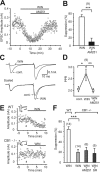

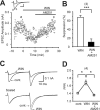
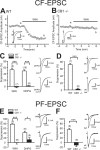
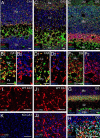
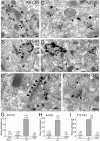
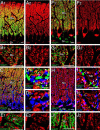
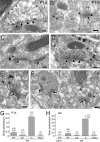
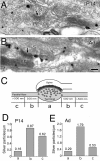
Similar articles
-
Cannabinoid receptor modulation of synapses received by cerebellar Purkinje cells.J Neurophysiol. 2000 Mar;83(3):1167-80. doi: 10.1152/jn.2000.83.3.1167. J Neurophysiol. 2000. PMID: 10712447
-
Involvement of cannabinoid receptors in the regulation of neurotransmitter release in the rodent striatum: a combined immunochemical and pharmacological analysis.J Neurosci. 2005 Mar 16;25(11):2874-84. doi: 10.1523/JNEUROSCI.4232-04.2005. J Neurosci. 2005. PMID: 15772347 Free PMC article.
-
Presynaptic cannabinoid sensitivity is a major determinant of depolarization-induced retrograde suppression at hippocampal synapses.J Neurosci. 2002 May 15;22(10):3864-72. doi: 10.1523/JNEUROSCI.22-10-03864.2002. J Neurosci. 2002. PMID: 12019305 Free PMC article.
-
Retrograde endocannabinoid signaling in the cerebellar cortex.Cerebellum. 2006;5(2):134-45. doi: 10.1080/14734220600791477. Cerebellum. 2006. PMID: 16818388 Review.
-
Distinct cannabinoid sensitive receptors regulate hippocampal excitation and inhibition.Chem Phys Lipids. 2002 Dec 31;121(1-2):73-82. doi: 10.1016/s0009-3084(02)00149-4. Chem Phys Lipids. 2002. PMID: 12505692 Review.
Cited by
-
Cannabinoid CB1 receptor expression in oligodendrocyte progenitors of the hippocampus revealed by the NG2-EYFP-knockin mouse.Front Neuroanat. 2022 Oct 28;16:1030060. doi: 10.3389/fnana.2022.1030060. eCollection 2022. Front Neuroanat. 2022. PMID: 36387996 Free PMC article.
-
Opposing local effects of endocannabinoids on the activity of noradrenergic neurons and release of noradrenaline: relevance for their role in depression and in the actions of CB(1) receptor antagonists.J Neural Transm (Vienna). 2013 Jan;120(1):177-86. doi: 10.1007/s00702-012-0900-1. Epub 2012 Sep 19. J Neural Transm (Vienna). 2013. PMID: 22990678 Review.
-
Inhibition of fatty acid amide hydrolase prevents pathology in neurovisceral acid sphingomyelinase deficiency by rescuing defective endocannabinoid signaling.EMBO Mol Med. 2020 Nov 6;12(11):e11776. doi: 10.15252/emmm.201911776. Epub 2020 Oct 5. EMBO Mol Med. 2020. PMID: 33016621 Free PMC article.
-
CB1R blockade unmasks TRPV1-mediated contextual fear generalization in female, but not male rats.Neuropsychopharmacology. 2023 Sep;48(10):1500-1508. doi: 10.1038/s41386-023-01650-z. Epub 2023 Jul 17. Neuropsychopharmacology. 2023. PMID: 37460772 Free PMC article.
-
The role of cannabinoids in modulating emotional and non-emotional memory processes in the hippocampus.Front Behav Neurosci. 2011 Jun 23;5:34. doi: 10.3389/fnbeh.2011.00034. eCollection 2011. Front Behav Neurosci. 2011. PMID: 21734875 Free PMC article.
References
-
- Alger BE (2002). Retrograde signaling in the regulation of synaptic transmission: focus on endocannabinoids. Prog Neurobiol 68:247–286. - PubMed
-
- Begg M, Pacher P, Batkai S, Osei-Hyiaman D, Offertaler L, Mo FM, Liu J, Kunos G (2005). Evidence for novel cannabinoid receptors. Pharmacol Ther 106:133–145. - PubMed
Publication types
MeSH terms
Substances
LinkOut - more resources
Full Text Sources
Molecular Biology Databases
